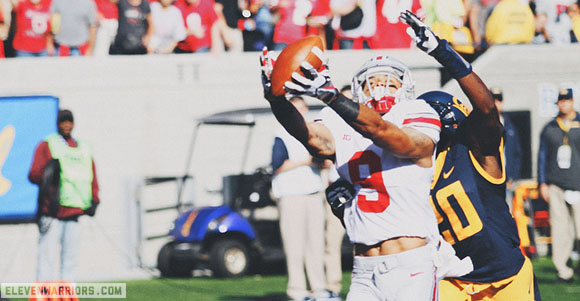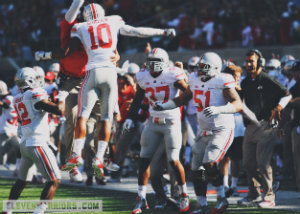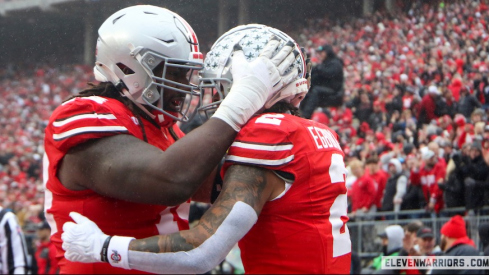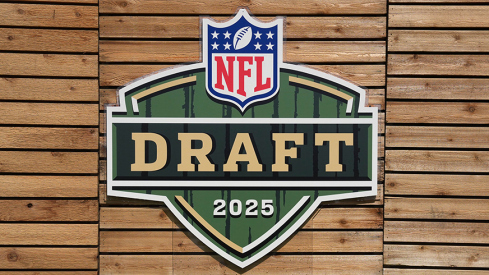
Just two years removed from Bauserball, 24.5 points per game and 5.12 yards per play, the Buckeyes are winning thanks to an explosive offense that plugs and plays, no matter who is in at the skill positions.
It was the confluence of Guiton and the Herman/Meyer system that just produced the sixth-most prodigious outing in Buckeye quarterback history: 368 total yards (276 passing and 92 on the ground), with a 66% completion rate, and absolutely perfect timing on the option all night.
And it wasn't just Guiton, but Hall, Devin Smith, and Dontre all turned heads tonight on offense, breaking a serious number of explosive plays against a Cal defense that never really considered trying to stop the Buckeyes last night.
| Yards/Play | Yards/Points | Points/Play | |
|---|---|---|---|
| Offense vs. Cal | 6.98 | 11.7 | .59 |
The offense had a prolific performance against Cal and Kenny G deserves praise as the fearless field general, but the numbers indicate that it was a little more inefficient than it looked on the surface. The Buckeyes' 6.98 yards per play was better than the 6.4 against SDSU, but both points-based metrics were slightly worse. That indicates that the Buckeyes could rack up the yardage, but not necessarily the points – the opposite of last season.
| Yards/Play | Yards/Points | Points/Play | |
|---|---|---|---|
| Defense Vs. Cal | 5.59 | 14.8 | .37 |
It's actually a little difficult to try and put the defense's performance in to perspective. On the one hand, the Buckeyes held Sonny Dyke's squad to just .37 points per play, which is about half a point per play more than last season's average. On the other hand, their 5.59 yards per play is a yard and a half more than the Buckeyes gave up to SDSU and a half yard more than last year.
Qualitatively, the Buckeyes still struggled with the same screens and quick slants that they have for a few years (but, to be fair, even the best defenses struggle with this stuff).
So is This a Championship-Caliber Defense?
That leads me to a question several posed in the forums following the game last night – despite getting gashed by a true freshman quarterback for 371 passing yards, is this defense championship material? Can the offense carry the load against a team like Bama, Oregon, or Clemson?
Cam Newton's 2010 Auburn team provides a fairly decent blueprint: good, but not stellar defense, plus an overwhelming number of points. Auburn held opponents to 5.36 yards per play and .35 points per play. That means that Auburn averaged roughly the same numbers as Ohio State against Cal – likely the best offense the team faces all season.
Against Cal, the defense gave up 3.6 yards per rush and seven yards per pass. These aren't world-beating numbers, but they're something to build off of. I don't think this unit is championship-caliber yet, but we'd probably be singing a different tune if not for a few explosive plays and poor excuses for tackling.
I was very encouraged by the play of a couple of guys in particular. Noah Spence keeps (somewhat quietly, actually) racking up sacks, Bennett is consistently disruptive inside, Bosa is playing lights-out for a freshman, Christian Bryant was perhaps the best defensive back on the field, and Shazier deserved his "damn" nickname based on team-leading tackles, a forced fumble, and a sack.
EXPLOSIONS IN THE SKY
That was a very exciting game to watch, mostly due to the number of explosive plays on both sides of the ball. The Buckeyes had nine of them, including three in the first two drives. We finally saw Dontre's pretty insane ability to get the edge and make defenders' angles look silly. That's 59 yards rushing on five carries and 48 yards receiving on three carries, or 13.4 yards per touch.
Of course, the defense also gave up four explosive plays, but it definitely seemed like more watching it live. Some of this can be explained by field position. Half of the Bears' scoring drives began at their 40 yard line or better, giving that explosive offense a short field to work with.
Regardless, it's great to win the explosive play ratio 9:4 – it's difficult to lose when you double the other team in this category.
(There'S Not A) Quarterback Controversy?
 Despite giving up 34, the defense had some to celebrate
Despite giving up 34, the defense had some to celebrateKenny G really played his heart out against Cal, throwing some excellent balls and being the nation's best at running the speed option. We've discussed this previously, but Guiton probably was forced to be an excellent decision maker in this offense because he lacks Braxton's insane physical abilities.
All of this led Twitter to wonder how many schools across the Big Ten Guiton would start for (like eight or nine).
However, that doesn't mean there's any real quarterback controversy at Ohio State. Let's compare their two starts this season:
| Comp % | Yards | AVG | TD | INT | QBR | |
|---|---|---|---|---|---|---|
| Braxton v. Buffalo | 15/22 | 178 | 8.1 | 2 | 1 | 71.1 |
| Kenny V. Cal | 21/32 | 276 | 8.6 | 4 | 0 | 85.5 |
It's clear that the coaches really trust Kenny in the passing game with his 32 passing attempts, but I don't think it's necessarily more than they trust Braxton. One thing I noticed when reviewing last season's stats is just how different the distribution of carries and receptions and overall gameplanning was in the first game compared with the rest of the season. Honestly, we're comparing just two performances against inferior opponents, where the Buckeyes noticeably eased off the gas in the second half against Buffalo (and SDSU).
Ohio State 52, Cal 34
I'm not sure if Braxton's Heisman chances are diminished after missing two games, but he's still going to put up some crazy numbers for the rest of the season – and we know the offense will be in great hands whenever he's on the sidelines.
Note Time
- Hall was crazy efficient with his 30 carries, with a 73% running back success rate. Dontre was at 80% on five carries. Unfortunately for Rod Smith's future workload, he came in at 33% on three carries. Is anyone else still surprised Dunn has yet to enter a game?
- Ohio State had seven penalties for 56 yards. Only two of those penalties were inconsequential, with the other five either ending in points for Cal or a punt for the Buckeyes.
- The Buckeyes ran an absurd 87 plays in 33:55, which is a play every 23.4 seconds – even faster than last week.
- The Buckeyes forced three three-and-outs and gave up just one of their own. A 3:1 three-and-out ratio is a sure recipe for success.
- Northwestern, who beat Cal 44-30, averaged .63 points per play and allowed .3 points per play on defense. Both were slightly better than the Buckeyes, though Northwestern also received three Goff interceptions.

